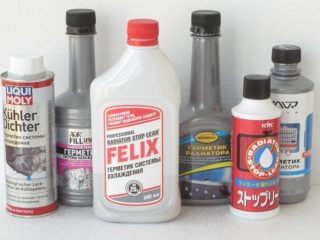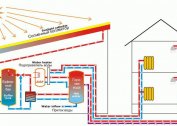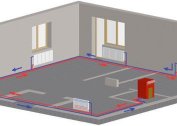Radiator leakage due to depressurization can be repaired with sealant. A special compound is also used during assembly or partitioning of sections. It is resistant to high temperatures of the coolant and provides high-quality tightness at the joints of all joints of the structure, eliminating open / hidden leaks in all areas of the heating system.
Composition and principle of action
The sealant for the radiator has excellent performance characteristics that make it possible to achieve complete sealing without much difficulty. The composition includes:
- acrylic polymers or oligomers - this is the basis responsible for the liquid consistency and subsequent complete curing during the drying process, additional substances are added to speed up the process;
- inhibitor stabilizers enhance the resistance of the composition to chemical media;
- functional additives are responsible for color, act as thickeners, improve resistance to alkalis, acids and other aggressive environments.
In the process of using sealant between the components, the necessary reaction occurs, coming into contact with metal elements, the composition fills all the bumps, cavities. After air no longer enters the hole, curing occurs. Outside, residues are cleaned with a cloth, a brush, and from the inside, excess is washed off with water.
Main requirements
The following requirements apply to sealants on the radiator:
- moisture resistance;
- heat resistance;
- resistance to sudden changes in temperature;
- resistance to deformation loads.
These qualities are necessary for the composition to fully fulfill all the tasks assigned to it and create a durable seal that is resistant to negative factors, without collapsing under the influence of a hot coolant.
Varieties of sealants
Sealant differs in type of application:
- external, used to apply to the leak site from the outside of the structure;
- the internal, most often a liquid composition, which flows into the heating system and determines the location of the defect under pressure, solving the problem from the inside;
- sealing, reinforcing joints, restores tightness.
The sealant is selected by type of damage, the availability of repairs.
Also, the sealing material is classified by composition:
- Acrylic Not all representatives of this series are suitable for heating mains, since not all instances tolerate temperature differences well. Therefore, the choice of brand should be treated as carefully as possible.
- Polyurethane They have increased elasticity, resistance to corrosion, optimal adhesion to metal surfaces, are not afraid of hot coolant.
- Silicone The main advantages are versatility, ductility, moisture resistance. The composition feels good in a wide range of temperature conditions. Available in liquid, pasty form. The second option has good adhesion to almost any surface, resistant to a variety of aggressive environments. The material easily finds and fills cavities, cracks, joints.
- Polymer. These representatives are specially used to eliminate leaks, polymerizing in direct contact with air.
Sealants are divided into acid and neutral.The first option is not applicable to heating systems where metal elements are present, since the composition can accelerate the corrosion process.
Each radiator repair fluid has its own purpose, so it is important to first verify what type of structure it is designed for:
- for OS operating on water;
- for systems running on antifreeze;
- for plastic pipes;
- to restore the sealing of metal surfaces.
Before making a purchase, it is important to read the instructions.
Radiator preparation for leak repair
Before eliminating the leak, it is important to carry out some preparatory measures. First of all, the desired concentration is determined. If within 24 hours the heating system has lost up to 80 liters of coolant, it is enough to fill in one liter of the selected sealant.
The action of the sealant is designed for a long period, but it gives a positive result only when used in pipes and radiators. If the problem touched the expansion tank, this method will not help.
Preparation steps for outdoor processing:
- coolant drains;
- the damaged area is determined;
- the area of the detected defect is cleaned of contaminants;
- degreasing the surface.
After all these actions, a new composition is applied. After the material has completely dried, liquid is poured into the system.
Preparation for sealing the internal type:
- Before starting work, all filters are removed / blocked, this will preserve their performance;
- all air comes down from the pipes, otherwise it is fraught with the appearance of blood clots in the process of uncontrolled polymerization of the sealant;
- OS cranes are opened to ensure free transportation of the repair compound in the working areas;
- a pump is installed in place of the dismantled Mayevsky crane, which delivers the sealant to the line;
- the OS starts and warms up to 60 ° C.
Compliance with all recommendations and rules will help to avoid negative consequences and carry out sealing effectively and efficiently.
How to use sealant
The amount of material depends on the brand, type of product. To achieve the desired effect, the concentration should be calculated as accurately as possible. The necessary ratios can be found in the instructions.
Calculation of the coolant is determined by the following methods:
- Direct measurement. The liquid is drained from the OS into the prepared container and the available volume is calculated.
- Indirect measurement. The following calculations are made: pipe length * cross-sectional area + volume of the radiator, boiler (numbers are indicated in the product passport). The norm of the sealing substance is determined.
Sealants, consisting of two components, must be mixed right before use.
Pouring process:
- A bucket of hot coolant is poured into a previously prepared container, another half a bucket of liquid is used in another container, which will be used for washing.
- The repair agent is shaken and added to the prepared tank with heated water or antifreeze.
- The resulting composition is instantly downloaded to the highway.
- The air goes down again.
Do not allow prolonged contact of the sealant with air, its transportation to the OS should be carried out as quickly as possible. The solution diverges along the line and within 4 days fills cracks, bumps, empty cavities. After this period, it is recommended that crimping be carried out under close supervision.
Sealing agents for heating radiators are easy to use. To carry out the procedure you do not need to be a professional, the event can be held independently.The composition quickly finds a leak and eliminates the problem without unnecessary difficulties, costly manipulations. During heating, it does not break down and maintains tightness for a long time, withstands elevated pressure readings.







